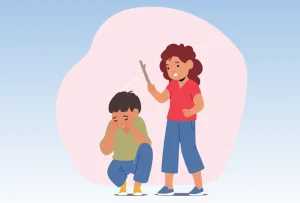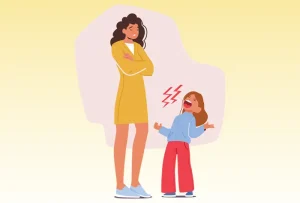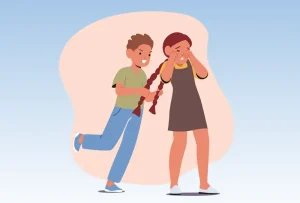by Erin Jones, photography by Nikola Tzenov
The Duties of Disciplining
How Should Parents Approach Behavior Issues with their Kids?
Kids! I don’t know what’s wrong with these kids today,” an exasperated Paul Lynde sang in the 1963 musical “Bye Bye Birdie.” While the song was written for laughs, the sentiment may still ring true in 2024.
In the age of viral videos, it’s easy to feel inundated with grim dispatches from within the walls of American schools. Physical fights, bullying, disrespect, and violence toward teachers are so regularly occurring that they begin to feel as commonplace as they are outrageous. Between the aftermath of the COVID-19 pandemic and the rapidly evolving and ubiquitous influence of technology, parents and educators face unchartered waters as behaviors become increasingly challenging.
As children and teens struggle in school and at home, how can the adults in their lives help them correct course?
 Effective discipline is ultimately rooted in relationships, says therapist Amy Heikkinen, LCSW-C. Heikkinen owns Carroll Creative Therapy, an outpatient psychotherapy practice in Westminster.
Effective discipline is ultimately rooted in relationships, says therapist Amy Heikkinen, LCSW-C. Heikkinen owns Carroll Creative Therapy, an outpatient psychotherapy practice in Westminster.
“I always say to parents ‘relationship before rules,’’’ Heikkinen says. Before doling out a consequence, parents should seek to understand the underlying cause of the issue. “There’s always a reason, no matter how nonsensical the behavior is.”
Asking questions about the situation before jumping straight to the consequences allows kids to share what happened. It also lets parents gain insight into what is causing the behavior.
Awareness of underlying causes can have a preventive benefit as well. “With every behavior having some sort of a cause, parents need to be aware of how we are inadvertently rewarding the behavior that we want to go away,” Heikkinen says.
If a child successfully gets more screen time after becoming rude and disrespectful, that behavior can become learned and reinforced.
Approaches to discipline change as the child ages and parental control becomes less and less.
“When our children are small, there’s so much control over the environment. We can put up a baby gate to prevent access; we have control over technology and transportation,” Heikkinen says. “Once kids are driving or can call a friend to get them, the level of control is so much less. Our impact becomes so much more bound up in our relationship.”
 That relationship between teens and parents is essential in maintaining open communication when the teen may be in trouble. “There’s an underlying sense of trust that I can go to my parents if things are bad. I made a bad decision and need help to get out,” Heikkinen says. “That relationship will bring our children back to us.”
That relationship between teens and parents is essential in maintaining open communication when the teen may be in trouble. “There’s an underlying sense of trust that I can go to my parents if things are bad. I made a bad decision and need help to get out,” Heikkinen says. “That relationship will bring our children back to us.”
The goal of discipline should also be ultimately instructive. Rather than simply deterring unwanted behavior, discipline should be a means of teaching the child on a deeper level.
“It’s not just about following the rules,” Heikkinen says. “What are your values? Who are you as a person? How do your actions show who you are? Consequences are intended to teach the correct things.”
These conversations should be part of discipline at home and an essential follow-up to discipline issues that arise at school.
“I’ve heard from some parents that if their child has an issue at school and then there are consequences at school, then parents can feel like the school’s handled it,” Heikkinen says.
While some incidents can be minor enough to be left in the school context, bigger issues warrant the parent’s reinforcement of in-school discipline and instructive conversations about the child’s character.
“If my child doesn’t know how to interact with their teacher through conflicts in a respectful way, or my child doesn’t know how to interact with peers in a safe way, or my child is cheating on a test, those are issues that are completely appropriate to address at home.”
Parental reinforcement at home strengthens the partnership between parents and teachers in tackling the more substantial problem of discipline issues in schools. A July 2022 study by the National Center for Education Statistics (NCES) that examined the effects of the COVID-19 pandemic found that “84% of public schools agreed or strongly agreed that students’ behavioral development has been negatively impacted.”
A Carroll County Board of Education work session this past March, available at carrollk12.org, presented a detailed breakdown of data on student behavior and discipline trends in Carroll County between 2021 and 2023. The findings showed behavior worsening, most severely at the elementary school level.
Cynthia Cook has several children at a CCPS (Carroll County Public Schools) elementary school. Last year, she had one child in first grade and one in fourth grade, and she observed the comparison between grade levels and the effect of the pandemic on her fourth grader and his classmates.
“Because of COVID, their entire experience has been different,” she says. “They were babies in kindergarten when the pandemic happened.”
 Cook notes that fourth-grade parents received emails last year about grade-level discipline issues, something she had never received before.
Cook notes that fourth-grade parents received emails last year about grade-level discipline issues, something she had never received before.
Technology presents another variable, even at the elementary level. While Cook and her husband have chosen to restrict their children’s use of personal technology, the school provides laptops to students in third through fifth grades, a resource that can seem like a double-edged sword.
“My concern with the school technology is that it doesn’t seem to be locked down very well,” she said, noting that students can access sites like YouTube despite knowing they are not supposed to. If there are systems in place that limit internet usage, Cook says, “the kids are smart enough to work around it.”
Technology also has made bullying more rampant and easier to conceal.
“Students are so savvy in knowing how to bully without it being detected by the adults that it can feel like nothing can be done. If they are trying to be mean, they find a way, regardless of the supervision of the adults,” Heikkinen says.
The difficulty in identifying and intervening in bullying has led to a sense of helplessness in students and a lack of trust in the adults around them. Heikkinen has heard from young clients that when problems arise in school, students do not trust that adults can solve the problem. “They can feel that going for help can make it worse. As a result, students are trying to solve problems on their own.”
Physical interaction was the most rapidly increasing category for major discipline referrals at the elementary school level, according to the March 18 report presented by CCPS Assistant Superintendent of Instruction Nicholas Shockney.

While middle and high school levels statistically showed a slight improvement in the number of major discipline referrals from 2021 to 2023, this area is not without concern. Bullying and conflicts have increased at the high school level, as well as the widespread practice of vaping.
Mount Airy resident Sara, who requested her last name to be omitted from this article, is the mother of a recent CCPS graduate and a rising junior. Her children have told her that marijuana usage is so rampant on buses and in school bathrooms that they avoid the bathrooms.
Sara also teaches elementary school in another county, which affords her the insight and perspective of both teacher and parent at the elementary and high school levels.
“As a parent, I’m glad my kids are almost out of school because there’s so many dangers and things that make it hard to learn between technology, drugs, and staff not always supporting kids. I don’t have an optimistic view of it,” she says. “I think it’s kind of broken.”
However, Sara believes additional support toward staffing and mental health support will have a positive effect. “They need more mental health support so students feel comfortable going to talk to someone about issues at home or in school, and they don’t need to turn to other things.”
Allocating resources to expand mental health support has shown signs of success in 14 CCPS schools that received compensatory education funding through the Maryland Department of Education’s Blueprint for Maryland’s Future initiative. These schools have received resources like mental health therapists, behavior support specialists, additional school psychologists, and mentor teachers to support newer faculty. Statistics from these schools show consistent improvement from 2021 to 2023.
“A lot of resources that we have trialed through comp-ed are working,” Shockney says. “As we put those in front of students and in schools, we have seen a positive effect.”
Recommendations presented at the end of the March 18 work session demonstrate an intent to continue this momentum.
In the meantime, Heikkinen encourages parents of struggling children and teens to seek support and know they are not alone. “There’s so much support available,” Heikkinen says, “whether it’s seeking a child therapist like me or looking for outside support. But the earlier that [request for help] happens, the more effective it usually is.”













